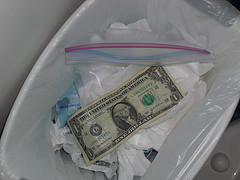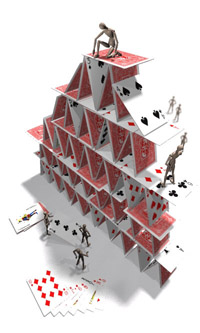 The only thing I could easily find in the whole place — with a “Made in the USA” label — was underwear. What I didn’t expect to find, was a mall heated by the sun (and body heat).
The only thing I could easily find in the whole place — with a “Made in the USA” label — was underwear. What I didn’t expect to find, was a mall heated by the sun (and body heat).
Forget the “conservative right” or “liberal left.” If America has a religion, it’s that of the consumption culture that has become the centerpiece for our economy. Now 70 percent of our GNP is based on its citizens purchasing stuff, on credit cards or otherwise.
This religion of consumption has its Mecca, too, called the Mall of America. A concept designed and constructed by the Triple Five Group — a privately held corporation owned by the Ghermezian brothers of Canada — Mall of America attracts more than 42 million visitors a year with their retail stores, restaurants, Nickelodeon Universe amusement park and Underwater Adventures Aquarium. While Mall of America is the most visited mall in the world, Triple Five Group also owns the biggest shopping mall in North America, the West Edmonton Mall.
Just for fun, I set out to find something that was made in America (and, ideally, without negatively impacting the environment). No, I didn’t think this was an insane goose chase. After all, more and more ecopreneurs I write about in ECOpreneuring are seeking to sell their “green products” through more conventional retail outlets – even big box stores and chains. That’s why Seventh Generation toilet paper can be now found at your local supermarket and nearly everyone, it seems, sells compact fluorescent bulbs these days. Perhaps one or two products might be here, in America’s megamall composed of 520 stores and 50 restaurants – housed under 4.2 million square feet of enclosed roof space. My odds should be good.
But my search was tougher than I thought. Having my son along with me on this adventure, I quickly realized I should have created a geography lesson for him based on what part of the world all these products were made. China won by a long shot, but there’s also Malaysia, Philippines, Bangladesh, South Korea and numerous others. UPS and FedEx must love this place, I thought, with all these products being shipped in from far away places.
I also reconnected with mainstream America, and with my suburban roots as a child (I’m now among the 2 percent of Americans who still farm). It didn’t take long for me to recognize how, as a nation, we’re proud of our allegiances to our sports teams and multinational corporations, boldly wearing t-shirts, hats and sweat pants emblazoned with logos: Harley Davidson (a company that makes more money selling clothing and gear then their motorcycles), Minnesota Vikings, Levi’s, Chicago Cubs, Nike, Iowa State, Old Navy, Green Bay Packers, Snap-on (“the tool for every toy”), just to name a few that I spotted in less than ten minutes of people watching.
And people there were, tens of thousands of them. By the time my son and I departed at about 4pm, I felt as if I was among the throngs of spectators exiting a large sporting competition. Unclear to me, at least, it was hard to discern whether some of these mall-goers were actually on a shopping trip or just hanging out to pass an afternoon (the MOA does encourage mall exercise walkers) or spend time with their family.
As its turns out, recent poll after poll reveal that the age of American consumerism may be coming to an end, or at least slipping in priority. Frugality and simplicity are on the rise. In a September 4, 2009 CNN Money poll, a paltry 8 percent of Americans would actually spend $10,000, if it were to suddenly appear in their bank account. Instead, about 42 percent would pay down debt, 26 percent would save it, and 25 percent would invest it. A related finding is echoed by a Echo Research for American Express Spending and Saving Tracker survey published by USA Today on November 15, 2009 which found that 20 percent of holiday shoppers were not even planning on shopping during this holiday season. So apparently I wasn’t alone, walking around the mall without gift bags in hand. My family is making our gifts this year, including luffa sponges and popcorn, both grown on farm.
Yet Mall of America remains near 95 percent occupancy, employing 11,000 to 13,000 workers depending on the season. International travelers are attracted to the mall as of late thanks to the falling value of the dollar; there are over 71 packaged tours to the mall from 32 countries. When my son and I visited, about 135,000 people spent some time at the mall, arriving by car, bus, shuttle vans from nearby hotels, or by light rail.
I grew weary of my quest for American-made products and started to ask workers in the various stores. When I asked Tanise, a worker at Gap Kids, if anything was made in the USA, she replied matter-of-factly: “I don’t think so.” After wandering around a bit, reading labels, I concluded she appeared correct. I found stylish and hip jeans, stone washed and with rips at the knees, for around $30; they were made in Bangladesh. Several other labels indicated Pakistan as country of origin (the same country where Osama Bin Laden is apparently hiding out). While smartly dressed girls and doting parents and grandparents buzzed around American Girl, service assistant Rachel cheerfully replied that “everything is now made in China.”
And on and on it went, until I finally came to American Apparel, manufacturers of underwear, t-shirts and other stylish clothing, some of which made from organic cottons and low-impact dyes — all made in the USA. American Apparel uses a vertically integrated business model that minimizes the use of sub-contractors and offshore labor. Knitting, dyeing, sewing, photography, marketing distribution and design all happen in their downtown Los Angeles facilities.
With a little more searching at Mall of America, you’ll also find artwork by local artists at Deck the Walls, Wisconsin-made cheeses at Rybicki Cheese (one of the few family-owned businesses in the mall), some Minnesota wines at Old Vine Wine and Spirits, and even some local and organic produce prepared into meals at the Crave restaurant, or some sustainably sourced selections at Chipotle.
I did discover something about the Mall of America I didn’t anticipate, however: a determined effort on the part of Mall of America to go green to save some green (and to some extent, reduce their ecological impacts). Despite the deep chills of Minnesota, the 4.2 million square foot mall has no central heating system. The Mall of America relies on passive solar heat with 8 acres of skylights and the body heat of the millions of visitors to heat the structure. To a lesser degree, heat given off by lighting and from individual retail stores accounts for some heat gain as well. Taking advantage of all the solar gain within the Mall of America, there are over 30,000 live plants and more than 2,000 live trees. To keep the plants healthy without the use of pesticides, over 100,000 ladybugs are released every year.
According to Dan Jasper with Mall of America, an aggressive recycling effort takes place in house and by hand, due to the difficulty they encountered while originally trying to get mall visitors to recycle properly in containers. “We need to do a better job communicating this to our guests,” admits Jasper, noting that no information is shared about their efforts to mall visitors.
Additionally, food waste at the mall is collected and eventually finds its way to a local hog farm. Waste fryer oil is turned into biodiesel and used in some of the Mall of America service vehicles. While the Mall of America still has a very long way to go in terms of their ecological (and social) impacts, their Phase II expansion plans will likely include LEED certified developments, says Jasper. In some ways, the Mall of America is an interesting redevelopment of the former site of Metropolitan Stadium where the Minnesota Vikings and Minnesota Twins played.
While I left as committed as ever to Main Street and family and locally-owned enterprises, I couldn’t deny that Mall of America has the ability (and perhaps responsibility?) to help transform our economy in ways that more Americans can accept. Mall of America possesses an appealing platform to help transform how we think about commerce and exchange. Perhaps, one day, Mall of America will embark on a program to sequester all the carbon dioxide spewed into the atmosphere by all their visitors and workers.
“The Mall of America represents our society at large, where people shop for things that are at the best price,” explains Jasper, who seemed excited about the mall’s recent transition to LED-lit Christmas decorations. “Unfortunately, most of these products are not made in the United States.”
Given climate change, the increasing cost of energy, and a host of other issues facing the planet, any inroads that this Mecca of America can make in terms of how we approach consumption could indeed, transform our world.
Photography: Courtesy of Mall of America








People need work — that spells money !
The lowest price on nearly everything is found
at WALMART !
Most items are made in other countrie!
And we or companies — out source !
What or where is choice ?
People need work — that spells money !
The lowest price on nearly everything is found
at WALMART !
Most items are made in other countrie!
And we or companies — out source !
What or where is choice ?
I have been with Triond for the past 1 year. I hope if I had got such suggestions, it would have been much more helpful for me. I learnt it the hard way. Hope the new comers an easier time.